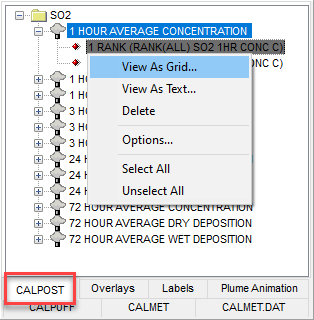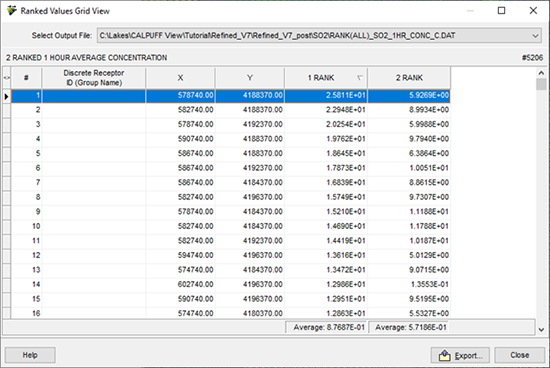U.S. EPA Updates AERMOD Modeling System to 23132 |
 |
|
On October 23, 2023, the U.S. EPA published updates to the AERMOD Modeling System as version 23132. The updates include new versions of AERMOD, AERMET, and the MMIF prognostic meteorological data utility.
Details of the release and lists of important changes can be found in the release memorandum on the EPA website. Major changes include:
|
- Options proposed for regulatory inclusion: RLINE, GRSM, & COARE overwater processing algorithm
- New ALPHA options: highly buoyant plumes, area source plume meander, aircraft source characterization
A full list of changes for each model can be found on the AERMOD, AERMET, and MMIF web pages. These updates immediately replace prior releases as the official regulatory versions of the models.
Using the latest models is important for many reasons:
- Ensures calculations are performed according to current state-of-science algorithms.
- Keeps facilities in compliance by using approved model versions.
- Allows modelers to test and provide vital feedback on new model options that will shape the future of air modeling.
Lakes Environmental is hard at work on updates to AERMOD View and AERMET View to incorporate the new models and associated changes. Be on the lookout for email communications from Lakes Environmental announcing availability of the new AERMOD View and AERMET View releases.
In today's fast-paced regulatory landscape, it's imperative that your team stays up to date with the latest version of AERMOD View. Doing so not only guarantees that your regulatory agency or industrial clients are in compliance, but also ensures they are using the official EPA AERMOD version.
If your copy of AERMOD View is no longer in maintenance, please contact our sales team at sales@webLakes.com for pricing to upgrade your license.
|
|
U.S. EPA Proposes Update to the Guideline on Air Quality Models |
|
On October 12, 2023, the U.S. EPA Administrator signed a proposed rule for revising the Guideline on Air Quality Models (Appendix W to 40 CFR Part 51). The Guideline defines EPA-recommended models and techniques for predicting ambient concentrations of air pollutants. Guidance for use of these models is also provided in the document.
Details of the proposed rule including technical support material can be found on the EPA’s website.
The public can formally submit comments on the proposed rule through December 22, 2023. The upcoming 13th Conference on Air Quality Models taking place in Research Triangle Park, North Carolina on November 14 and 15 will serve as the formal public hearing for the proposed rule.
Lakes Environmental will be attending the Conference, and we look forward to seeing the modeling community in North Carolina!
|
|
Online AERMOD Training Course – Jan 16-17, 2024 |
 |
Our 2023 courses are all sold out! Don’t miss our 2-day online AERMOD course taking place on January 16 and 17, 2024 from 8:30am to 5:00pm (Central Time – Chicago, USA).
Register today before space is gone!
Note: Due to the immense popularity of our online courses and small class sizes, we recommend registering and making payment as soon as possible.
|
|
Online CALPUFF Training Course – Jan 23-24, 2024 |
 |
Our team will present 2 days of online CALPUFF training on January 23 and 24, 2024 from 8:30am to 5:00pm (Central Time – Chicago, USA)
Space is limited. Register today!
|
|
UPCOMING TRAINING COURSES |
|

|
MODELING TIP |
New Ranked Values Grid View in CALPUFF View |
|
Last month’s tip discussed the new Top-50 Table Viewer, one of the new additions to CALPUFF View Version 10.0 which aids modelers in visualizing output from the CALPOST postprocessor. Another addition to this release of CALPUFF View is the Ranked Values Grid View.
CALPOST’s Ranked Values are similar to the “Highest Values” option found in the Output Pathway of the AERMOD air dispersion model. Modelers define the ranked output value, and the model results are ordered on a receptor-by-receptor basis with the user-defined values reported.
For example, specifying a Ranked Value of 2 will return the 2nd highest value from each receptor for the selected species, process, and averaging period. CALPOST can calculate up to four ranked values ranging from the 1st to the 10th rank. After a successful CALPOST run, CALPUFF View uses the data to generate contour plots of each selected rank, species, process, and averaging period.
With the release of Version 10.0, modelers can now view the Ranked Values output in a gridded table viewer to extract and analyze model output more easily. To access the Ranked Values Grid View:
- Go to the CALPOST Tree View tab found in the bottom-left of the application window.
- Select the desired Ranked Values plot file from the list of species.
- Right-click the file to open the context menu.
- Select the “View As Grid” selection from this context menu.


The information from the plot file is displayed in an easy-to-read grid format. The information can be sorted by column by clicking on the column header. You can also drag and drop the columns to change the order in which they are displayed. The average value of each rank column is displayed on the bottom panel, under the RANK column.
The numeric value in each RANK column represents the Ranked Value as specified in the CALPOST Options - Ranked Values settings. For example, “1 RANK” represents the highest output values (Rank 1).
At the top of this dialog, the name and location of the plot file is displayed. From this drop-down list you can select which plot file you wish to view in grid format. Below this, a description of the plot file can be seen along with the total number of receptors.
The data can also be exported to CSV format using the  button at the bottom of the dialog. button at the bottom of the dialog.
|
|

|
ENVIRONMENTAL NEWS ARTICLES |
Climate Change Brings Earlier Arrival of Intense Hurricanes |
October 6, 2023 - Intense tropical cyclones are one of the most devastating natural disasters in the world due to torrential rains, flooding, destructive winds, and coastal storm surges. New research co-authored by a University of Hawai‘i at Manoa atmospheric scientist revealed that since the 1980s, Category 4 and 5 hurricanes (maximum wind speed greater than 131 miles per hour) have been arriving three to four days earlier with each passing decade of climate change. Their findings were published recently in Nature.
Read more → |
|
AI-Driven Earthquake Forecasting Shows Promise in Trials |
October 6, 2023 - A new attempt to predict earthquakes with the aid of artificial intelligence has raised hopes that the technology could one day be used to limit earthquakes’ impact on lives and economies. Developed by researchers at The University of Texas at Austin, the AI algorithm correctly predicted 70% of earthquakes a week before they happened during a seven-month trial in China.
Read more → |
|
|
|
UPCOMING CONFERENCES |
2023 Conference Schedule |
|
13th Conference on Air Quality Models
Nov 14-15, 2023 | Research Triangle Park, NC
Learn more →
|
|
|
LAKES SOFTWARE GROUP OF COMPANIES
|
 |
1-170 Columbia St. W.
Waterloo, ON N2L 3L3
View Online
This newsletter contains information gleaned from various sources on the web, with complete links
to the sources cited. Organizations cited are in no way affiliated with Lakes Environmental Software.
For more information, please visit our web site at: www.webLakes.com.
All comments and suggestions are welcome. You can e-mail us at: support@webLakes.com.
Privacy Policy |
|
| | |
